Understanding the post Budget rally: How the global factors can impact it

The post Budget rally is continuing for the third consecutive day with the Sensex up by around 250 points and Nifty up around 75 points after two hours of trading on Thursday morning. In our blog post yesterday, Understanding the post Budget market rally: Will it be sustainable we had discussed the market dynamics and technical factors leading to the rally. In this post, we will discuss the fundamental global factors and the outlook.
Global factors have had a far greater influence on the direction of the Indian equity markets in the last one year compared to domestic factors. In the back-drop of the challenging global macro-economic situation, Foreign Institutional Investors (FIIs) have sold off large parts of emerging market portfolio over the past year. As a result the Indian equities, which are part of the emerging market basket, especially large cap stocks, fell by more than 20% in the last one year. We will not go into the global macro factors that have led to the 20% decline in the market in this article (if you are interested, we have discussed these factors in our post, What can we expect the equity market to do in 2016). In this blog we will briefly discuss two specific factors that led to decline in January and February of this year leading up to the Budget. Our belief is that, if you understand these two factors, even at a high level and continue to track them, you will get a sense of the intermediate term market direction over the coming months. These two factors are crude prices and trajectory of interest rates in the US economy. Other factors like, China, Euro zone etc will also be important, but in our view, crude and the US interest rates will be more important in determining the direction of the global equity markets.
Crude Oil
Let us discuss crude first. The chart below shows the daily price chart of crude oil futures over the past two years. Prices are in US dollars per barrel.
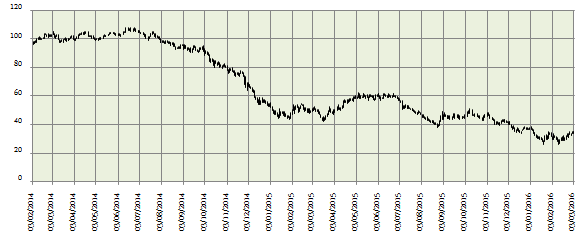
Source: Investing.com
You can see that crude oil declined from over $100 / barrel to around $30 / barrel, more than a 70% fall in prices. There are various theories as to why crude prices fell so much; maybe we can devote a whole article to it, but the simple fact is that, going by the fundamental law of economics, supply of crude oil far exceeds demand. Is not fall in crude prices good for consumers? Yes, fall in crude prices is good for consumers because their expense on fuel goes down and they can save more or spend more in the other areas. In fact, for an oil importing economy like India, this fall in crude prices has helped in controlling inflation and also fiscal deficit. While fall in crude prices is good for consumers, from a macro-economic viewpoint, the fall in crude prices is a clear indicator that, the global demand, especially industrial demand is slowing down. Over the past one year or so, there has been a clear correlation between crude prices and equity market. Currently crude is trading at $34 – 35 / barrel. How much further can crude fall? Some commodity experts have said that crude can fall to $20 / barrel. You should take their viewpoint in the right perspective. Just because they are saying it can go to $20, it does not mean it will fall to $20. In fact, crude has stabilized at around $30 – 35/ barrel in the last few days. The extreme pessimistic view of crude at $20 should be used as a reference point, just in case crude price breaks down below $30. $20 / barrel is around 40% lower than current levels; therefore one can expect equity markets to go much lower than the current levels and in fact even lower than the 52 week low made by market. So what can we expect crude to do in the coming weeks? The laws of technical analysis apply to crude prices also just like share prices (we had discussed some basic technical analysis tools in our post, Where will the stock market bottom out: A technical perspective). Please see below the technical chart of crude over the last one year
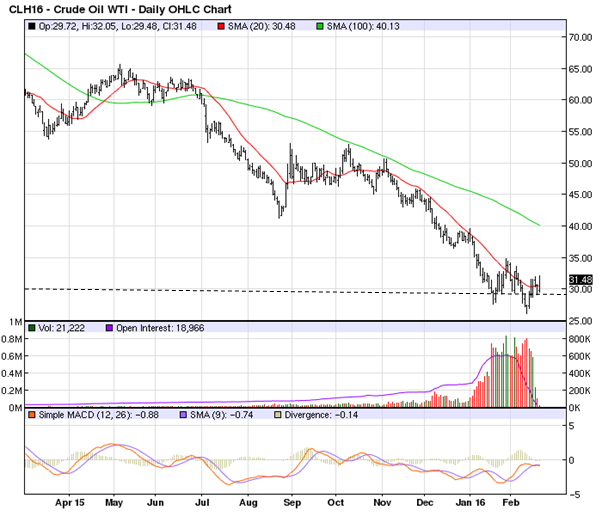
Source: Barcharts.com
The dotted line shows that crude has some support at $30 / barrel. The 20 DMA is below the 100 DMA which is bearish. But look at the MACD oscillator (the histogram at the bottom of the chart). It has moved into the positive territory, which shows some upward momentum. In fact, yesterday crude oil futures rose 0.8% and closed higher for 3 consecutive days in a row. Look at the open interest build-up at $30 – 35 / barrel, which shows some buying support coming in at those levels. The support which crude is getting at $30 – 35 / barrel has given strength to the global markets. If you thought that, the nearly 1,500 point post Budget rally in the Sensex is due to the Budget only, you should know that equity markets across the world have gained strength in the last 3 days, though the quantum of the up move has differed from market to market. Crude prices over the last few days have played an important role in the moves that we are seeing in equity markets. Has crude bottomed out at around $30 a barrel? We cannot say this with a lot of conviction because the DMA is still bearish, and therefore this uptrend may be reverse in the intermediate term, but for now $30 seems to be a good support. You should track crude prices using both technical analysis and also developments taking place in the market. It will give you important clues with respect to the near term direction of equity markets.
US Interest Rates and the economy
Investors who follow stock markets know that, stock markets around the globe follow the US stock market. If the Dow Jones and S&P – 500 closes higher tonight, it is more likely than not that, the Asian markets, including our market, will open higher tomorrow morning and vice versa. The US economy is the largest in the world and has a huge influence on the global economy. On the other hand, if the global economy is weak, it can affect the US economy also. Our view is that, the US economy, if strong, can drag the global economy out of a recession, simply by virtue of its size. On the other hand, if the US economy is weak, then it is not good for the global economy also. We wanted to stress this point, because, we in Advisorkhoj believe that what happens in the US economy is far more important to India, than what happens in China or other large countries. Let us now focus on what happened in the US stock markets in the first two months of the year, leading up to the Union Budget. 2016 was the worst start ever for US equity markets. The S&P – 500 lost $1.4 Trillion in market capitalization in just the first 10 days of the year. The repercussions of what happened in the US market were felt in India too; in fact, on a percentage basis our market declined much more than the US. At the start of this article, we had said that, we will not go into the history of what happened in stock markets and the economy in the last one year, but to understand the negative sentiment in the US market at the beginning of the year, we have to go back one month, before the start of the year.
In December 2015, the US Federal Reserve raised its policy rates by 25 basis points, after almost a decade. There were two conflicting views on the Fed rate hike. One view concurred with the Fed that, the US economy had showing signs of strengthening and therefore, there was no need to keep the Fed Funds rate at very low rate close to zero. The other view was that, there was no conclusive evidence that the US economy was growing and therefore, increase in interest rates would cause the US economy to go into recession. Increase in interest rates reduces liquidity, which helps in controlling inflation but also slows down the GDP growth, other factors remaining constant. The initial reaction to the Fed rate hike in December was positive, which meant that the market believed that the US economy was on strong footing. However, that view quickly changed in January itself, as the market feared that the weakness in the global economy would impact the US economy also. Also, the market was not convinced about the strength of the US economy based on the data of leading economic indicators.
You should remember that most central banks around the world, including the US Fed or our own RBI, follow a data driven approach to monetary policies. Though there are several important leading economic indicators, the two most important economic indicators of the US economy are the jobless claims and the manufacturing index (also known purchasing manager’s index or PMI) data. The chart below shows the weekly jobless claims data of the US over the last 5 years. The jobless claims are on a declining trend, as you can see in the chart, and this is the primary driver of the Fed’s conviction that the US economy is strengthening.
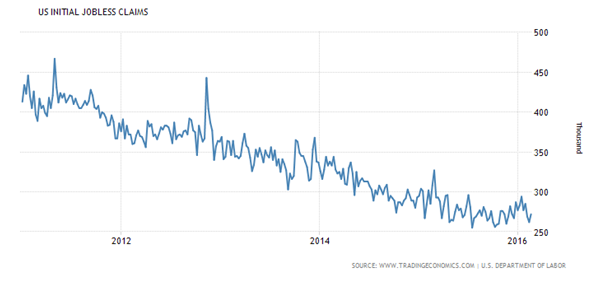
Source: Trading Economics
While the jobless claims data is encouraging the PMI data, which is essentially the performance of the manufacturing sector in the US, was telling a slightly different story. The chart below shows the PMI data in the US over the last 5 years. You can see in the chart below that the PMI has been declining since 2014 onwards.
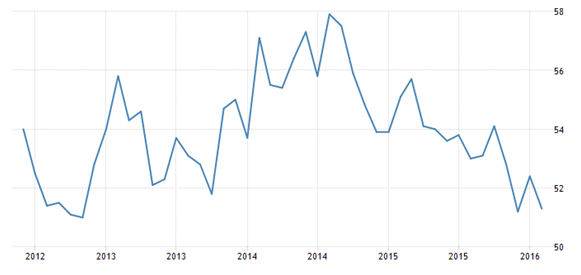
Source: Trading Economics
The lack of conviction in the US economy, exacerbated by global fears around China, led to the bears taking over the US market. The market feared that interest rate hike by the Fed will only worsen the state of the US economy. You should remember that, while in the long term economic performance is correlated with stock market performance, in the short term that might not be the case. In the short term, market is driven by sentiments and risk aversion. Unfortunately, the Q4 results declared by US companies was not good at all. Average earnings per share (EPS) fell on a year on year basis for S&P 500 companies. In our previous blog post Understanding the post Budget market rally: Will it be sustainable, we had discussed how bears use risk aversion and negative sentiments to drive down share prices and make profits. The negative sentiments caused the S&P 500 to go into the oversold territory. In fact, Marc Faber, a well known bear, in a recent interview to CNBC said that the S&P – 500 was indeed oversold and that the relief rally that we are seeing right now can take the S&P – 500 to much higher levels. How do we know, we are in the oversold territory? Unfortunately, there is no sure way of knowing that, because in a bear market, share prices keep going down and down. However, there are short term indicators which can say, whether the market is overbought or oversold. Readers should please note that, in a strong bull or bear market, it really does not matter, if the indicators are suggesting overbought or oversold. If the sentiment is overwhelmingly bullish or bearish, market will do what is has to do, irrespective of what the indicators are saying. With this caveat, let us introduce another technical indicator, Relative Strength Index or RSI. We will not go into a detailed explanation of RSI because this is not a technical analysis blog, but for the benefit of our readers, we will briefly explain what RSI is and more importantly, how to use RSI, to gauge market moves. The Relative Strength Index (RSI) is one of a group of technical indicators known as momentum oscillators. RSI measures the velocity and magnitude of directional price moves of an asset and it is represented graphically by oscillating between 0 and 100. RSI is used to gauge overbought or oversold conditions. If asset is overbought, then it may correct in the short term and if it is oversold, then it may rally in the short term. As per technical analysis, when RSI moves above 70, the asset is thought to be overbought and when the RSI moves below 30, the asset is thought to be oversold. The chart below shows the 1 year price chart of S&P – 500 and RSI oscillator.
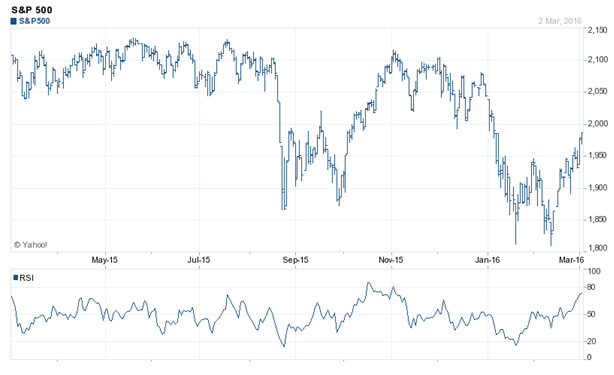
Source: Yahoo Finance
You can see in the chart above that the RSI of S&P – 500 moved below 30 in January 2016, indicating oversold situation in the market. Therefore, as per technical analysis, a rally was forthcoming. But keep a watch on the RSI and be careful when it approaches 70.
We explained the factors that led to the US market decline in January and February, and the subsequent recovery in the last few days. You should keep a watch on these factors, namely the US leading economic indicators, e.g. jobless claims data, PMI etc and more importantly the commentary of the US Federal Reserve. If you are unable to follow the US leading economic indicators data, simply follow what the Fed has to say. In the market you will hear multiple and often conflicting voices. In our opinion, it is better to be anchored to one viewpoint, so that you can make good investment decisions. In this case, we suggest that, unless you are an economic expert, you simply follow what the Fed has to say. If the Fed thinks that the US economy is on a strong footing and that they will raise interest rates in a calibrated manner in the future, it is not a bad sign for equity market, including India. Further hikes in US interest rates may attract more investments in US Treasuries, but from a medium to long term perspective, it is extremely positive for global markets, including India, if the US economy is strong.
Conclusion
In this blog post, we discussed the various global factors, both fundamental and technical, that have been at play this year. These global factors are, in our opinion, more important than the domestic factors in our economy at least as far as short to moderate term market movement is concerned. But if you are interested in the domestic factors, primarily the Budget and its potential impact on the stock markets, please tune in to our blog tomorrow. We will discuss the domestic factors, impact of the Budget and more importantly, what fixed income and equity investors should do in our post tomorrow (to be continued).
Queries
-
What is the benefit of mutual fund STP
Aug 29, 2019
-
How much to invest to meet target amount of Rs 2 Crores
Aug 26, 2019
-
Can I achieve my financial goals with my current mutual fund investments
Aug 24, 2019
-
Can you tell me return of various indices
Aug 19, 2019
-
What would be the post tax return on different investments
Aug 18, 2019
-
Which Principal Mutual Fund scheme will be suitable for my retirement corpus
Aug 16, 2019
-
What is the minimum holding period for availing NCD interest
Aug 4, 2019
Top Performing Mutual Funds
Recommended Reading
Fund News
-
The Wealth Company Mutual Fund launches The Wealth Company Gold ETF FOF
Jan 9, 2026 by Advisorkhoj Team
-
Mahindra Manulife Mutual Fund launches Mahindra Manulife Innovation Opportunities Fund
Jan 9, 2026 by Advisorkhoj Team
-
Jio BlackRock Mutual Fund launches Jio BlackRock Short Duration Fund
Jan 8, 2026 by Advisorkhoj Team
-
Jio BlackRock Mutual Fund launches Jio BlackRock Low Duration Fund
Jan 8, 2026 by Advisorkhoj Team
-
Groww Mutual Fund launches Groww Small Cap Fund
Jan 8, 2026 by Advisorkhoj Team














